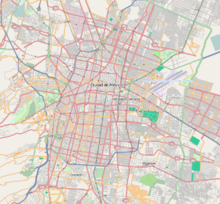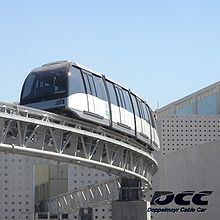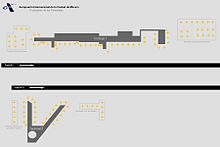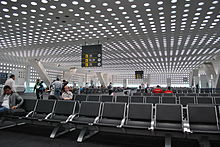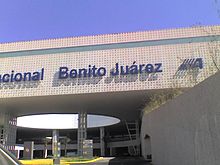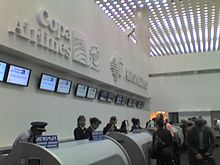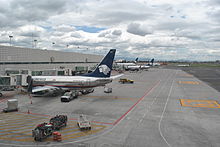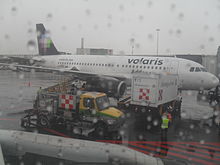- Mexico City International Airport
-
Benito Juarez International Airport
Aeropuerto Internacional de la Ciudad de México Benito Juárez
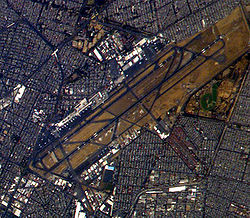
Mexico City International Airport as seen from a satellite before the construction of Terminal 2. IATA: MEX – ICAO: MMMX Summary Airport type Civil Owner Grupo Aeroportuario de la Ciudad de México Operator Aeropuertos y Servicios Auxiliares Serves Mexico City, Mexico Location Venustiano Carranza, D.F. Hub for Elevation AMSL 7,316 ft / 2,230 m Coordinates 19°26′10″N 099°04′19″W / 19.43611°N 99.07194°WCoordinates: 19°26′10″N 099°04′19″W / 19.43611°N 99.07194°W Website Map Location within Mexico City Runways Direction Length Surface m ft 05R/23L 3,900 12,795 Asphalt 05L/23R 3,952 12,966 Asphalt Statistics (2010) Aircraft Movements 339,898 Passengers 24,130,535 Cargo tonnage 393,075.87 Source: DAFIF[1][2] Benito Juárez International Airport (Spanish: Aeropuerto Internacional de la Ciudad de México Benito Juárez or AICM), (IATA: MEX, ICAO: MMMX) in Venustiano Carranza, one of the sixteen boroughs into which Mexico's Federal District is divided, is a commercial airport that serves Mexico City, the capital of Mexico. It is Mexico's busiest airport by both passenger traffic and aircraft movements. Although this was not its official name for several decades, it was formally named after the 19th century president Benito Juárez in 2006, and is Mexico's main international and domestic gateway. The airport is owned by Grupo Aeroportuario de la Ciudad de México and operated by Aeropuertos y Servicios Auxiliares, the government-owned corporation, who also operates 21 others airports through Mexico. In recent years Toluca Airport has become an alternate airport.
This hot and high airport is served by 32 domestic and international airlines and offers direct flights to more than 100 destinations worldwide. In 2010, the airport served 24,130,535 passengers. In optimal conditions, and with the current renovations and expansion projects completed, the Benito Juárez airport will be able to handle up to 32 million passengers per year.[3] It provides non-stop services from Mexico City to North America, Central America and Caribbean, South America, Europe and Asia (Aeromexico is the only airline that flies to Asia from Mexico City).
As the main hub for Mexico's largest airline Aeroméxico and a secondary hub for its subsidiary Aeroméxico Connect, the airport has become a SkyTeam hub. It is also a hub for Aeromar, Interjet and a focus city for VivaAerobus and Volaris.
Mexico City International Airport is the Latin America's second busiest airport by passenger traffic after Guarulhos Airport in São Paulo, Brazil and the busiest airport by aircraft movements. The airport houses a wide variety of lodging options for its passengers, including hotels inside Terminal 1 (the Hilton Hotel and the Camino Real, and the Fiesta Inn), as well as a NH Hotel at Terminal 2.
Contents
Location
The airport is 5 km. east from central Mexico City. The airport is surrounded by the built-up areas of Gustavo A. Madero to the north and Venustiano Carranza to the west, south and east. As the airport is east Mexico City and its runways run southwest-northeast, and airliner's landing approach is usually directly over Mexico City. Therefore, there is an important overflying problem.
History
The airport first opened as Balbuena Military Airport with five runways. The first landing was on November 5, 1928 and regular service started a year later, but was officially inaugurated on May 15, 1931. Its first international route was to Los Angeles International Airport operated by Mexicana. President Miguel Alemán opened the terminal in 1952, thus becoming a commercial airport. In the 1970s, president Luis Echeverría closed three runways and gave that land to poor people in order to build their homes, leaving just two parallel runways. In 1980, the terminal was expanded to double its capacity, using a single large terminal rather than multiple terminals as in other airports. Ten years later in 1990, the mixed domestic/international gates were separated to increase the terminal's functionality, along with the separation of domestic and international check-in halls.
In 2001, the east wing of the terminal was opened as an international final call waiting area and was mainly used by SkyTeam members. Because of the increasing demand, president Vicente Fox announced the construction of a new, larger airport on 5,000 hectares (12,000 acres) in the municipalities of Texcoco and San Salvador Atenco, but when local violent protests aroused, the new airport was cancelled. Instead, he launched a program called Expansion of Mexico City Airport to its Maximum Capacity in 2002 to increase the airport's capacity. The whole terminal was expanded and upgraded with new check-in halls, 13 more baggage claim belts, the construction of Departures and Arrivals floors, construction of several new taxiways and a whole new terminal opposite of the original, thus breaking the single terminal concept. The project was started with an initial investment of $200,000,000 MXP. Nevertheless, its final cost was $800,000,000 MXP. The original quasi-Terminal 2, which only housed Aeromar's operations in and out the airport was demolished, and the new Terminal 2 was built in less than two years.
On November 15, 2007, Terminal 2 was opened, increasing the airport's operational capacity by 40%. All SkyTeam members moved their operations to it, except Air France and KLM. It was officially inaugurated on March 2008, once the new road accesses and taxiways were finished. Terminal 2 increased the airport's contact positions by 40%, and the operational capacity by 15%.
Lack of capacity and slot restriction
The airport has suffered from a lack of capacity due to restrictions for expansion, since it is located in a densely-populated area. Some analysts have reported that if the airport had grown at the same speed as demand, it would now serve over 40 million passengers annually. The main issue with the airport is the limitation that its two runways provide, since they are used at 97.3% of their maximum capacity, leaving a very short room for new operations into the airport. Only government, military, commercial and specially authorized aircraft are allowed to land at the airport. Private aircraft must use alternate airports, such as Lic. Adolfo Lopez Mateos International Airport in Toluca, General Mariano Matamoros Airport in Cuernavaca or Hermanos Serdán International Airport in Puebla. Even with the inauguration of the new Terminal 2, the airport would be ideally designed to serve around 18 million passengers per year, according to the international standards for runway and terminal usage. Instead, the airport will keep increasing the number of passengers from around 26 million passengers in 2008 at a rate of 16% per year.
Terminals and facilities
Terminals
Mexico City International Airport has two passenger terminals. Terminal 1 is separated from the other by the runways. Terminal 2 is connected to Terminal 1 by the Aerotrén monorail system in which only connecting passengers with hand baggage are allowed to use with their boarding pass. Technical and cabin crew can also use it. Normal operation hours are from 5:00 am to 11:00 pm, every day of the year, and the first run always begins from T2 to T1; the last run of the day is to T2. The distance between the terminals is 3 km. and the Airtrain's speed is 45 km. per hour. The Airtrain journey, once the doors are fully closed therefore takes approximately 4 minutes and 40 seconds between stations in both directions. Also, if you arrive as a train is leaving the maximum waiting period for the next train is 11 minutes. Also there is a land service between terminals called "inter-terminal transportation". These buses are located at entrance no. 6 of Terminal 1 and entrance no. 4 of Terminal 2.
Terminal 1
- Opened in 1958; expanded in 1970, 1989, 1998, 2000 and 2004
- Overall terminal surface: 548,000 sq meters
- Contact positions: 33
- Remote positions: 20 (34 Before New T2 was built)
- Number of jetways: 32
- Number of airside halls: 10 (A, B, C, D, E, F, G, H, I, J)
- Number of landside (check-in) halls: 9 (A1, A2, B, C, D, D1, F1, F2, F3)
- Number of mobile-lounges: 11 (A7-A, A7-B, A7-C, A9-A, A9-B, A9-C, A9-D, A9-E, F19-A, F19-C, F19-D)
- Hotel service: 600 rooms (Camino Real), 110 rooms (Hilton)
- Parking service: 3,100 vehicles (Domestic), 2,400 vehicles (International)
- Space per passenger in T1: 17 sq meters
- Number of baggage claiming carousels: 22
- Premium Lounges in T1: Salón Premier Internacional T1 (Aeroméxico), Red Carpet Club (United Airlines), Admirals Club (American Airlines), American Express Lounge (American Express), Elite Lounge Nacional (Mexicana), Elite Lounge Internacional (Mexicana).
Mexico City's Terminal 1 is currently the largest airport terminal in the Americas and the fourth largest in the world.
Terminal 2
- Opened in 2007
- Overall terminal surface: 242,000 sq meters
- Contact positions: 23
- Remote positions: 17 (Aeromar and Aeromexico Connect)
- Number of jetways: 23
- Number of airside halls: 2 (Domestic, International)
- Number of landside (check-in) halls: 3 (L1, L2, L3)
- Hotel service: 287 rooms (NH)
- Parking service: 3,000 vehicles
- Space per passenger in T2: 22 sq meters
- Number of baggage claiming carousels: 15
- Premium Lounges in T2: Club Diamante (Aeromar), Salón Premier (Aeroméxico), Salón Premier Internacional T2 (Aeroméxico), Riedel Wine Room (Aeroméxico) , Travel Pass Elite Lounge (Banamex) , Centurion American Express Lounge American Express.
- Platform surface: 426,000 sq meters
- Inter-terminal Aerotrén capacity: 7,800 daily passengers
Terminal 2 is now housing all Aeroméxico flights out of the airport, becoming the airline's main distribution center. Although the terminal was intended to be served by all-SkyTeam member airlines, Air France and KLM decided to remain at Terminal 1.
Airlines and destinations
AeroMéxico Boeing 777-200ER is taking off from Mexico City airport to Shanghai Pudong International Airport.
Airlines Destinations Terminal/
ConcourseAerolíneas Argentinas Buenos Aires-Ezeiza 1 Aeromar Acapulco, Aguascalientes, Ciudad Victoria, Colima, Durango, Huatulco, Ixtapa/Zihuatanejo, Lázaro Cárdenas, Manzanillo, Matamoros, Minatitlán/Coatzacoalcos, Morelia, Nuevo Laredo, Piedras Negras, Poza Rica, Puerto Escondido, Reynosa, Saltillo, San Luis Potosí, Tepic, Veracruz, Xalapa
Seasonal: San Antonio21 Aeroméxico Barcelona, Bogotá, Buenos Aires-Ezeiza, Cancún, Caracas, Chicago-O'Hare, Fresno, Guadalajara, Havana, Las Vegas, Lima, Los Angeles, Madrid, Miami, Monterrey, Montréal-Trudeau, New York-JFK, Orlando, Paris-Charles de Gaulle, San Antonio, San Francisco, San José de Costa Rica, San José del Cabo, Santiago de Chile, São Paulo-Guarulhos, Shanghai-Pudong, Tijuana, Tokyo-Narita
Seasonal: Denver, Houston-Intercontinental, Ontario2 North Aeroméxico Cancún, Chihuahua, Ciudad Juárez, Culiacán, Guadalajara, Hermosillo, Mérida, Mexicali, Monterrey, Oaxaca, San José del Cabo, Tijuana, Tuxtla Gutierrez, Villahermosa
Seasonal: Acapulco, Ciudad del Carmen, Mazatlán, Puerto Vallarta, Reynosa, Torreón/Gómez Palacio, Veracruz2 South Aeroméxico Connect Guatemala City, Houston-Intercontinental, Mérida, Miami, San Antonio, San Pedro Sula 2 North Aeroméxico Connect Acapulco, Aguascalientes, Campeche, Chihuahua, Ciudad del Carmen, Ciudad Juárez, Ciudad Obregón, Colima, Culiacán, Durango, Guadalajara, Huatulco, Ixtapa/Zihuatanejo, La Paz, León/El Bajío, Los Mochis, Matamoros, Mazatlán, Mérida, Mexicali, Minatitlán/Coatzacoalcos, Monterrey, Morelia, Nuevo Laredo, Oaxaca, Poza Rica, Puerto Vallarta, Reynosa, San José del Cabo, San Luis Potosí, Tampico, Tapachula, Tijuana, Torreón/Gómez Palacio, Tuxtla Gutiérrez, Veracruz, Villahermosa, Zacatecas 2 South Air Canada Toronto-Pearson, Vancouver 1 Air Europa Madrid 1 Air France Paris-Charles de Gaulle 1 Alaska Airlines Los Angeles 1 American Airlines Chicago-O'Hare, Dallas/Fort Worth, Miami 1 Avianca Bogotá 1 British Airways London-Heathrow 1 Continental Airlines Houston-Intercontinental, Newark 1 Continental Express operated by ExpressJet Airlines Houston-Intercontinental 1 Copa Airlines Panama City 2 North Copa Airlines Colombia Bogotá 2 North Cubana de Aviación Havana 1 Delta Air Lines Atlanta, Detroit, New York-JFK, Salt Lake City 2 North Iberia Madrid 1 Interjet Acapulco, Cancún, Chetumal, Chihuahua, Ciudad del Carmen, Ciudad Juárez, Ciudad Obregón, Cozumel, Culiacán, Guadalajara, Guatemala City, Havana, Hermosillo, Huatulco, Ixtapa/Zihuatanejo, Mérida, Monterrey, Puerto Vallarta, San Antonio [begins December 1], San José del Cabo, Tampico, Tijuana, Tuxtla Gutiérrez, Veracruz, Villahermosa 1 KLM Amsterdam 1 LAN Airlines Santiago de Chile 2 North LAN Perú Lima 2 North Lufthansa Frankfurt, Munich [begins March 27, 2012][4] 1 Magnicharters Cancún, Huatulco, Ixtapa/Zihuatanejo, Mérida, Puerto Vallarta, San José del Cabo
Seasonal: Manzanillo1 TACA Airlines San Salvador 1 TACA Airlines operated by Lacsa Guatemala City, San José de Costa Rica 1 TACA Perú Lima 1 TAM Airlines São Paulo-Guarulhos 1 United Airlines Chicago-O'Hare, Los Angeles, San Francisco, Washington-Dulles
Seasonal: Denver1 US Airways Charlotte, Phoenix 1 VivaAerobus Campeche, Cancún, Ciudad Juárez, Guadalajara, Huatulco, Mazatlán, Mérida, Monterrey, Oaxaca, Puerto Escondido, Tampico, Torreón/Gómez Palacio, Tuxtla Gutiérrez, Villahermosa 1 Volaris Cancún, Chicago-Midway, Chihuahua, Culiacán, Guadalajara, Hermosillo, La Paz, Las Vegas, Los Angeles, Mexicali, Monterrey, Oakland, San Diego, San José del Cabo, Tijuana, Zacatecas 1 - Notes
- ^1 Aeromar has remote positions, just north of Terminal 2.
Other services.
Cargo airlines
As of July 2011, Mexico City airport is served by 16 cargo airlines flying directly to Europe, North and South America. The following airlines operate the following scheduled destinations.
Airlines Destinations ABX Air Los Angeles, San José de Costa Rica AeroUnion Chicago-O'Hare, Guadalajara, Los Angeles Air France Cargo Guadalajara, Houston-Intercontinental, Paris-Charles de Gaulle, Porto Amerijet International Miami Atlas Air Huntsville Cargolux Atlanta, Guadalajara, Houston-Intercontinental, Luxembourg, Miami, New York-JFK Centurion Air Cargo Bangor (ME), Miami Cielos Airlines Lima DHL Express operated
by Astar Air CargoCincinnati/Northern Kentucky, Miami DHL de Guatemala Guatemala City Estafeta Mérida, San Luis Potosí, Villahermosa Florida West International Airways Bogotá, Miami Lufthansa Cargo Chicago O'Hare, Dallas/Fort Worth, Frankfurt MasAir Bogotá, Buenos Aires-Ezeiza, Campinas-Viracopos, Caracas, Guadalajara, Guayaquil, Lima, Los Angeles, Manaus, Medellín-Córdova, Miami, Quito, Santiago de Chile Tampa Cargo Bogotá UPS Airlines Louisville World Airways Milan-Malpensa Airlines providing on-demand cargo services
- Aeromexpress
- Air Cargo Carriers
- Air Transport International
- Ameristar Jet Charter
- IFL Group operated by Contract Air Cargo
- Kalitta Air
- Líneas Aéreas Suramericanas
- Martinair Cargo
- Regional Cargo
- USA Jet Airlines
- Volaris Cargo
Other facilities
Aeropuertos y Servicios Auxiliares, a government-owned corporation that operates airports in Mexico, has its headquarters on the airport property.[5] The Aeromar headquarters are located in Hangar 7 in Zone D of the General Aviation Terminal of the airport.[6][7] Aviacsa has its headquarters in Hangar 1 in Zone C.[8]
Traffic statistics
Year Total passengers[9] % change Aircraft movements % change Cargo [TM] % change 2006 24,727,296  2.5
2.5355,593  6.9
6.9- - 2007 25,881,662  4.7
4.7378,161  6.3
6.3- - 2008 26,210,217  1.3
1.3366,561  3.1
3.1376,095.71 - 2009 24,243,056  7.5
7.5348,306  5.0
5.0321,133.44  14.61
14.612010 24,130,535  0.46
0.46339,898  2.4
2.4393,075.87  22.40
22.402011 [Jan-Oct]
21,466,128 6.71
6.71288,189  0.80
0.80336,891.85  4.72
4.72Operations
Busiest international routes at Mexico City International Airport [2010][10] Rank City Passengers Rank change Carriers 1  Los Angeles, CA, USA
Los Angeles, CA, USA665,399 
Aeroméxico, Alaska, United, Volaris 2  Houston, TX, USA
Houston, TX, USA621,097  2
2Aeroméxico, Aeroméxico Connect, Continental, ExpressJet Airlines 3  New York, NY, USA (JFK and Newark airports) 1
New York, NY, USA (JFK and Newark airports) 1590,506  1
1Aeroméxico, Continental, Delta 4  Miami, FL, USA
Miami, FL, USA553,836  1
1Aeroméxico, Aeroméxico Connect, American 5  Madrid, Spain
Madrid, Spain496,443 
Aeroméxico, Air Europa, Iberia 6  Dallas, TX, USA
Dallas, TX, USA404,351 
American 7  Paris, France
Paris, France386,259 
Aeroméxico, Air France 8  Chicago, IL, USA
Chicago, IL, USA310,838 
Aeroméxico, American, United 9  Atlanta, GA, USA
Atlanta, GA, USA269,571  2
2Delta 10  Panama City, Panama
Panama City, Panama267,889  1
1Copa 11  Bogotá, Colombia
Bogotá, Colombia253,483  3
3Aeroméxico, Avianca, Copa Airlines Colombia 12  San Francisco, CA, USA
San Francisco, CA, USA237,148  2
2Aeroméxico, United 13  Frankfurt, Germany
Frankfurt, Germany215,922 
Lufthansa 14  San José, Costa Rica
San José, Costa Rica211,408  1
1Aeroméxico, LACSA 15  Lima, Peru
Lima, Peru210,628  9
9Aeroméxico, LAN Perú, TACA Perú 16  São Paulo, Brazil
São Paulo, Brazil196,396  3
3Aeroméxico, TAM Airlines 17  Amsterdam, Netherlands
Amsterdam, Netherlands177,627  1
1KLM 18  Phoenix, AZ, USA
Phoenix, AZ, USA173,614  9
9US Airways 19  Las Vegas, NV, USA
Las Vegas, NV, USA167,256  2
2Aeroméxico, Volaris 20  Santiago de Chile, Chile
Santiago de Chile, Chile161,807  2
2Aeroméxico, LAN 21  Guatemala City, Guatemala
Guatemala City, Guatemala157,273  9
9Aeroméxico, TACA, Interjet 22  Havana, Cuba
Havana, Cuba153,980  2
2Aeroméxico, Cubana, Interjet 23  Toronto, Canada
Toronto, Canada145,180  7
7Air Canada 24  Buenos Aires, Argentina
Buenos Aires, Argentina128,748  3
3Aerolíneas Argentinas, Aeroméxico 25  London, United Kingdom
London, United Kingdom126,732  2
2British Airways Busiest domestic routes at Mexico City International Airport [2010] Rank City Passengers Rank change Carriers 1  Cancún, Quintana Roo
Cancún, Quintana Roo1,973,959 
Aeroméxico, Interjet, Magni, VivaAerobus, Volaris 2  Monterrey, Nuevo León
Monterrey, Nuevo León1,837,278 
Aeroméxico, Aeroméxico Connect, Interjet, VivaAerobus, Volaris 3  Guadalajara, Jalisco
Guadalajara, Jalisco1,628,333 
Aeroméxico, Aeroméxico Connect, Interjet, VivaAerobus, Volaris 4  Tijuana, Baja California
Tijuana, Baja California824,865 
Aeroméxico, Aeroméxico Connect, Interjet, Volaris 5  Mérida, Yucatán
Mérida, Yucatán755,921 
Aeroméxico, Aeroméxico Connect, Interjet, Magni, VivaAerobus 6  Tuxtla Gutiérrez, Chiapas
Tuxtla Gutiérrez, Chiapas596,567 
Aeroméxico, Aeroméxico Connect, Interjet, VivaAerobus 7  Villahermosa, Tabasco
Villahermosa, Tabasco518,667 
Aeroméxico, Aeroméxico Connect, Interjet, VivaAerobus 8  Veracruz, Veracruz
Veracruz, Veracruz433,227 
Aeromar, Aeroméxico, Aeroméxico Connect, Interjet 9  Hermosillo, Sonora
Hermosillo, Sonora428,656 
Aeroméxico, Interjet, Volaris 10  Puerto Vallarta, Jalisco
Puerto Vallarta, Jalisco370,790  1
1Aeroméxico, Aeroméxico Connect, Interjet, Magni 11  Acapulco, Guerrero
Acapulco, Guerrero358,185  1
1Aeromar, AeroMéxico, Aeroméxico Connect, Interjet 12  Los Cabos, Baja California Sur
Los Cabos, Baja California Sur338,306  1
1Aeroméxico, Aeroméxico Connect, Interjet, Magni, Volaris 13  Tampico, Tamaulipas
Tampico, Tamaulipas332,108  1
1Aeroméxico Connect, Interjet, VivaAerobus 14  Chihuahua, Chihuahua
Chihuahua, Chihuahua317,052  5
5Aeroméxico, Aeroméxico Connect, Interjet, Volaris 15  Oaxaca, Oaxaca
Oaxaca, Oaxaca316,627  1
1Aeroméxico, Aeroméxico Connect, VivaAerobus 16  Ciudad Juárez, Chihuahua
Ciudad Juárez, Chihuahua305,852  1
1Aeroméxico, Aeroméxico Connect, Interjet, VivaAerobus 17  Bahías de Huatulco, Oaxaca
Bahías de Huatulco, Oaxaca300,159  1
1Aeromar, Aeroméxico Connect, Interjet, Magni, VivaAerobus 18  Culiacán, Sinaloa
Culiacán, Sinaloa294,714 
Aeroméxico, Aeroméxico Connect, Interjet, Volaris 19  León/El Bajío, Guanajuato
León/El Bajío, Guanajuato233,362  2
2Aeroméxico Connect 20  Torreón/Gómez Palacio, Coahuila
Torreón/Gómez Palacio, Coahuila230,791  3
3Aeroméxico, Aeroméxico Connect, VivaAerobus 21  Ixtapa/Zihuatanejo, Guerrero
Ixtapa/Zihuatanejo, Guerrero217,276  1
1Aeromar, Aeroméxico Connect, Interjet, Magni 22  Ciudad del Carmen, Campeche
Ciudad del Carmen, Campeche214,147 
Aeroméxico, Aeroméxico Connect, Interjet 23  Mexicali, Baja California
Mexicali, Baja California200,680 
Aeroméxico, Aeroméxico Connect, Volaris 24  Tapachula, Chiapas
Tapachula, Chiapas181,337  ?
?Aeroméxico Connect 25  Mazatlan, Sinaloa
Mazatlan, Sinaloa180,091 
Aeroméxico Connect, VivaAerobus - Notes
- ^1 Official statistics include JFK and Newark airports.
Ground transportation
Metro and bus services
The airport is served by the Terminal Aérea Metro station, which belongs to Line 5 of the subway, running from Pantitlán station to Politécnico station. It is located just outside the T1's national terminal.Terminals 1 and 2 have two land terminals operating 24 hours a day, 365 days a year. Different bus lines operate from here [2], and provide continuous transportation services to the main cities located around Mexico City, such as Córdoba, Cuernavaca, Pachuca, Puebla, Querétaro, Tlaxcala and Toluca. The Terminal 1 land terminal is located in front of the international area vehicular ramp and its facilities include various services for the comfort of the passengers. Among others, it offers VIP lounges, internet, resting, reading and meeting halls. The Terminal 2 land terminal is located at gate D, between entrance 4 and the national arrival passenger exit, and its facilities include resting halls and a fast food area.
Authorized taxis
Taxis are in operation in Terminals 1 and 2 and there are two models of service: Ordinary service in a sedan type vehicle for 4 passengers. Executive service in 8 passengers vans. At present there are 5 taxi groups in operation. These are the only taxis authorized by the Ministry of Communications and Transport (SCT) of the Federal Government. The Terminal 1 taxi boarding areas are located at entrances 1 and 10; and in Terminal 2, boarding areas are located at entrances 3 and 4. Taxi rates are registered under the SCT and include passenger insurance, civil liability and medical expenses for all occupants. To receive the taxi service you must purchase the corresponding ticket previously at the authorized sale points located within the airport.
Accidents and incidents
- On 10 April 1968, Douglas R4D-3 XA-GEV of Aerovías Rojas crashed on approach, killing all eighteen people on board. The aircraft was operating a domestic scheduled passenger flight, which was the airline's inaugural flight from Aguascalientes International Airport to Mexico City.[11]
- On October 31, 1979, Western Airlines Flight 2605 crash-landed. The crew of the DC-10 had landed on the wrong runway and the jetliner hit construction vehicles that were on the closed runway. There were 78 fatalities (including one on the ground) and 14 survivors.
- An Aero California DC-9-15 overran in 2006, during an intense storm at the airport. There were no victims, but the aircraft was scrapped. However, a woman died later due to a heart attack.[citation needed]
- On September 9, 2009, hijacked Aeroméxico Flight 576 landed at Mexico City International Airport from Cancun International Airport.
- On September 13, 2009, Lufthansa Cargo McDonnell-Douglas MD-11 D-ALCO was damaged in a heavy landing. Post landing inspection revealed that there were wrinkles in the fuselage skin and the nose gear was bent.[12] According to a Lufthansa spokesman, the aircraft will be repaired and returned into full service.[13]
See also
- List of the busiest airports in Mexico
References
- ^ Airport information for MMMX at World Aero Data. Data current as of October 2006.Source: DAFIF.
- ^ Airport information for MEX at Great Circle Mapper. Source: DAFIF (effective Oct. 2006).
- ^ "BEGIN SERVICE IN THE AICM T2: Aeromexico, Aeromexico Connect, COPA & LAN (In Spanish)". Mexico City International Airport. http://www.aicm.com.mx/acercadelaicm_en/AICMinforma/index.php?Publicacion=82. Retrieved January 25, 2010.
- ^ http://presse.lufthansa.com/en/news-releases/singleview/archive/2011/september/01/article/1998.html
- ^ "Home." Aeropuertos y Servicios Auxiliares. Retrieved on December 20, 2010. "Av.602 No.161 Col.Zona Federal Aeropuerto Internacional Ciudad de México Delegación Venustiano Carranza, C.P.15620, México D.F."
- ^ "Directory: World Airlines." Flight International. March 16–22, 2004. 50. "Hangar 7, Zona "D", Terminal de Aviacion General, Col Federal, Mexico DF, 15620, Mexico"
- ^ "DIRECTORIO DE OFICINAS DE VENTAS." Aeromar. August 16, 2007. 3/7. "CORPORATIVO MEXICO Hangar No. 1 Zona "D" Col. Federal 15620 México, D. F."
- ^ "Directorio." Aviacsa. Retrieved on January 23, 2011. "DIRECCIÓN COMERCIAL Hangar 1, Zona "C", Col. Aviación Gral. [...] Aeropuerto Int. de la Cd. de México. C.P. 15520"
- ^ "Statistics Mexico City Airport". Mexico City International Airport. http://www.aicm.com.mx/acercadelaicm_en/Estadisticas/. Retrieved January 25, 2010.
- ^ [1] 2010 Origin-Destinations statistics. Secretariat of Communications and Transportation. Retrieved on January 22, 2011 (In Spanish)
- ^ "XA-GEV Accident description". Aviation Safety Network. http://aviation-safety.net/database/record.php?id=19680410-1. Retrieved 24 July 2011.
- ^ "Accident: Lufthansa Cargo MD11 at Mexico City on Sep 13th 2009, hard landing". The Aviation Herald. http://avherald.com/h?article=4210beec&opt=0. Retrieved 11 October 2009.
- ^ "Lufthansa Cargo wird D-ALCO in Stand setzen". aero.de/Aviation Media & IT. http://www.aero.de/news-9099/Lufthansa-Cargo-wird-D-ALCO-in-Stand-setzen.html. Retrieved 24 October 2009.(German)
External links
Categories:- Airports in Mexico
- WAAS reference stations
- Transportation in Mexico City
Wikimedia Foundation. 2010.

